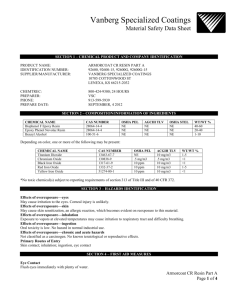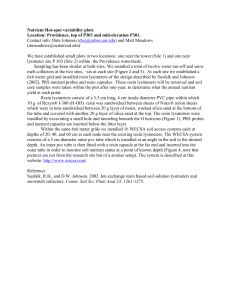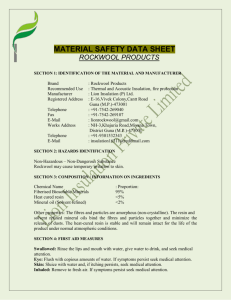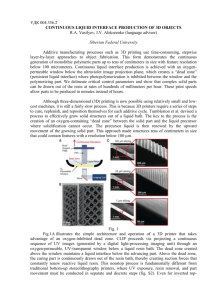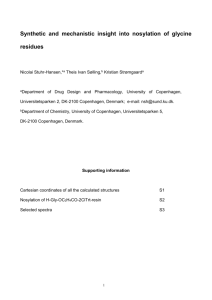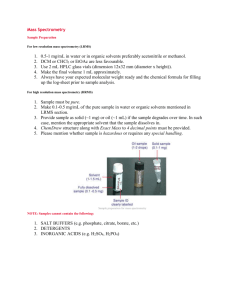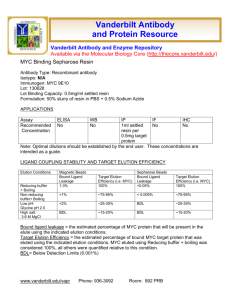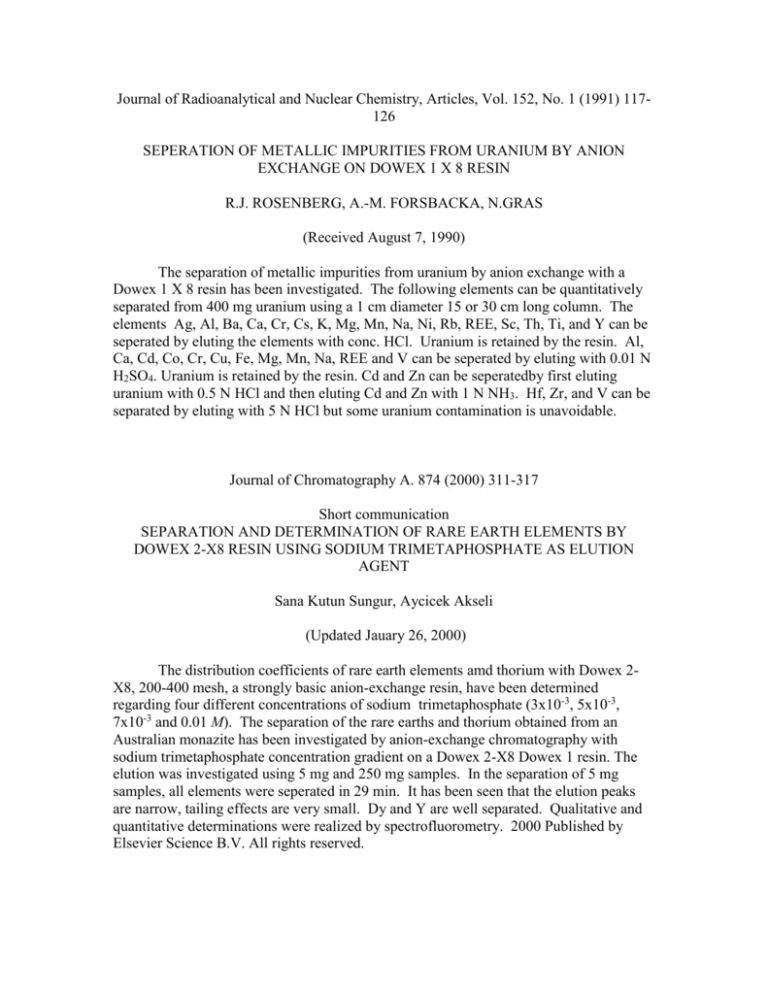
Journal of Radioanalytical and Nuclear Chemistry, Articles, Vol. 152, No. 1 (1991) 117126
SEPERATION OF METALLIC IMPURITIES FROM URANIUM BY ANION
EXCHANGE ON DOWEX 1 X 8 RESIN
R.J. ROSENBERG, A.-M. FORSBACKA, N.GRAS
(Received August 7, 1990)
The separation of metallic impurities from uranium by anion exchange with a
Dowex 1 X 8 resin has been investigated. The following elements can be quantitatively
separated from 400 mg uranium using a 1 cm diameter 15 or 30 cm long column. The
elements Ag, Al, Ba, Ca, Cr, Cs, K, Mg, Mn, Na, Ni, Rb, REE, Sc, Th, Ti, and Y can be
seperated by eluting the elements with conc. HCl. Uranium is retained by the resin. Al,
Ca, Cd, Co, Cr, Cu, Fe, Mg, Mn, Na, REE and V can be seperated by eluting with 0.01 N
H2SO4. Uranium is retained by the resin. Cd and Zn can be seperatedby first eluting
uranium with 0.5 N HCl and then eluting Cd and Zn with 1 N NH3. Hf, Zr, and V can be
separated by eluting with 5 N HCl but some uranium contamination is unavoidable.
Journal of Chromatography A. 874 (2000) 311-317
Short communication
SEPARATION AND DETERMINATION OF RARE EARTH ELEMENTS BY
DOWEX 2-X8 RESIN USING SODIUM TRIMETAPHOSPHATE AS ELUTION
AGENT
Sana Kutun Sungur, Aycicek Akseli
(Updated Jauary 26, 2000)
The distribution coefficients of rare earth elements amd thorium with Dowex 2X8, 200-400 mesh, a strongly basic anion-exchange resin, have been determined
regarding four different concentrations of sodium trimetaphosphate (3x10-3, 5x10-3,
7x10-3 and 0.01 M). The separation of the rare earths and thorium obtained from an
Australian monazite has been investigated by anion-exchange chromatography with
sodium trimetaphosphate concentration gradient on a Dowex 2-X8 Dowex 1 resin. The
elution was investigated using 5 mg and 250 mg samples. In the separation of 5 mg
samples, all elements were seperated in 29 min. It has been seen that the elution peaks
are narrow, tailing effects are very small. Dy and Y are well separated. Qualitative and
quantitative determinations were realized by spectrofluorometry. 2000 Published by
Elsevier Science B.V. All rights reserved.
JOURNAL OF CHROMATOGRAPHY
ANION EXCHANGE CHROMATOGRAPHY OF TRANSITION METALS IN
TARTRATE MEDIUM
GERALD P. MORIE AND THOMAS R. SWEET,
(Received January 27TH, 1964)
The tartrate complexes of chromium , molybdenum, nickel, silver, cadmium and
mercury were studied by the batch equilibration method on Dowex 2x-8 anion exchange
resin. From the distribution coefficients obtained for the above metals and for
manganese, cobalt, zinc and iron, several column separations were developed.
Radioisotopes were used in the batch equilibration studies and in the chromatographic
separations.
ANALYST, FEBUARY 1989, VOL.114
DETERMINATION OF IRON SPECIES IN WINE BY ION-EXCHANGE
CHROMATOGRAPHY – FLAME ATOMIC ABSORPTION SPECTROMETRY
Radmila Ajlec and Janez Stupar
The direct coupling of ion-exchange chromatography to flame atomic absorption
spectrometry (AAS) has been achieved by employing a Babington type nebuliser. The
system enables all the processes on the column to be followed directly at flow-rates of
between 1 and 5ml min-1. The potential of the system was investigated for the
determination of various iron species in synthetic samples containing iron(II) and
iron(III) in ionic or chelated form by employing various ion-exchange (Dowex 50-X8,
Dowex 1-X8) and sorptive (Amberlite XAD-2) resins, respectively. In some instances
where direct coupling was impossible, owing to the physical properties of effluent or
eluent, conventional analyses of chromatography separated iron species were preformed
by flame AAS. The optimum concentration range, limit of detection and reproducibility
of measurement were also determined for a particular column capacity. When direct
coupling was employed, the detection limit for the separated iron species was 15 g with
a relative standard deviation (RSD) of -+3% and, using the conventional method of
analysis, 2-5 g with an RSD of -+1%. On the basis of these results the system was
applied to the determination of the ratio of iron(II) to iron(III) in wines.
Analytica Chimica Acta, 138 (1982) 285-294
ACCURATE DETERMINATION OF TRACE AMOUNTS OF THORIUM IN
SILICATE ROCKS BY CATION-EXCHANGE CHROMATOGRAPHY AND
SPECTROPHOTOMETRY
A.H. VICTOR and F.W.E. STRELOW
October 30, 1981
Thorium in four of the South African NIMROC standards and in four secondary
standards is determined accurately by means of spectrophotometry with arsenazo-III after
a selective cation-exchange seperation on an AG50W-X4 resin column. All other
elements are eluted with 6 M hydrobromic acid before the final elution of thorium woth
5M nitric acid. Small amounts of zirconium which may be presant in the thorium eluate,
are effectively complexed with oxalic acid which eliminates the spectrophotometric
interferences caused by organic material leached from the resin column. The accuracy
and precision of the method are demonstrated by the analysis of synthetic mixtures
containing various amounts of thorium. Amounts of 10 and 100 g of thorium can
finally be determined with coefficients of variation of 1% and 0.2%, respectively.
Analytica Chimica Acta, 215 (1988) 317-323
DETERMINATION OF TRACE ELEMENTS IN MANGANESE METAL AND
COMPOUNDS BY ION-EXCHANGE CHROMATOGRAPHY AND ATOMIC
ABSORPTION SPECTROMETRY
A.M.M.M. FAISCA and A.H. VICTOR
July 28th, 1987
Traces of the specified elements are separated from 1g of manganese(II), using a
30-g column of AG50W-X8 cation-exchange resin and mixtures of hydrochloric acid and
acetone as eluents. The trace elements are separated into three groups and are determined
by atomic absorption spectrometry, except uranium for which spectrophotometry is used.
Recoveries for 10 g amounts (20 g for gallium) vary between 94% (for gallium) and
103% (for uranium). A combined elution curve, results for the analysis of synthetic
mixtures and for the determination of ten trace elements in samples of manganese metal,
chloride and dioxide are presented.
Analytica Chimica Acta 290 (1994) 371-377
PRECONCENTRATION OF TRACE ELEMENTS FROM HIGH-PURITY THORIUM
AND URANIUM ON CHELEX-100 AND DETERMINATION BY GRAPHITE
FURNACE ATOMIC ABSORPTION SPECTROMETRY WITH ZEEMAN-EFFECT
BACKGROUND CORRECTION
Naina Raje, Satish Kayasth, T.P.S. Asari, S. Gangadharan
November 30th, 1993
Preconcentration of trace impurities from large-sized samples of uranium metal
and thorium oxide using a small column of Chelex-100 followed by their determination
using graphite furnace atomic absorption spectrometry (GFAAS) is reported. A 0.5-10-g
amount of the sample (uranium metal of thorium oxide) was dissolved, complexed with
ammonium carbonate and subjected to the ion-exchange procedure. The retained
analytes were eluted with 2-4 M nitric acid and brought to a small volume for a final
dilution to 10-25 ml for their determination using GFASS. The validity of the separation
procedure and recoveries at g kg-1 levels was checked by standard addition; the
recoveries were > 95%.
Analyst, January 1990, VOL.115
DETERMINATION OF TRACE AMOUNTS OF CADMIUM, LEAD, COPPER AND
ZINC IN NATURAL WATERS BY INDUCTIVELY COUPLED PLASMA ATOMIC
EMISSION SPECTROMETRY WITH THERMOSPRAY NEBULISATON, AFTER
ENRICHMENT ON CHELEX-100
Koen Vermeiren, Carlo Vandecasteele and Richard Dams
Enrichment on Chelex-100, followed by evaporation when necessary, was used
for the pre-concentration of Cd, Pb, Cu, and Zn from natural waters. The measurements
were carried out with inductively coupled plasma atomic emission spectrometry using a
thermospray nebulisation system to reach the required sensitivity. The detection limits
corresponding to three times the standard deviation of the blank (in 1% v/v HNO3) after a
30-fold enrichment are 0.02 g 1-1 for Cd, 0.33 g 1-1 for Cu and Zn. Matrix effects,
which are fairly serious with thermospray nebulisation, were taken into account by using
the standard additions method. Results obtained for several river water samples were
compared with those found by analysis of thenon-enriched sample with inductively
coupled plasma mass spectrometry or graphite furnace atomic absorption spectrometry.
In all instances the agreement was satisfactory.
Journal of Radioanalytical and Nuclear Chemistry, Articles, Vol. 172, no. 1 (1993) 43-48
SORPTION OF SILVER IONS BY CHELEX 100 CHELATING RESIN
R.N.Ceo, M.R. Kazerouni, K. Rengan
June 3, 1992
Cationic species
At pH <3, no sorption of silver occurs. At low pH, Chelex 100 has positively
charged sites available for anion exchange, but the carboxl groups on the resin are not
ionized. Since the only silver species in solution are cationic, no sorption is possible. At
pH>3, however, carboxyl groups begin to deprotonate and complete sorption occurs.
The silver is gradually eluted at pH 7 and above. The elution may be due to competion
between the resin’s functional groups and ammonia molecules in solution. The effect is
more pronounced at pH 9, since the increase in [OH-] causes an equillibrium shift
favoring formation of molecular ammonia. The results are consistent with the change of
distribution coefficients with pH reported by YOSHIZUKA et al.7 Their results predict
strong sorption from ammoniacal solutions around pH 5 and weak sorption at pH<3 and
pH>8, as observed in our experiments.
Anionic species
At low chloride concentration, Chelex 100 sorbs silver efficiently. Silver exists in
these solutions as an anionic complex, sorption is efficient even up to pH 7. Presumably
the exchange occurs at the NH+ site. The results reported here are consistent with the
values reported by KHUN and HERING3 and by RILEY and TAYLOR.4 GOYA and
LAI6 reported 43.3% sorption of silver. However they used a batch process with 0.25g of
resin for 20 ml of seawater. The small amount of resin used (approximately 3% of those
used in other investigations) may account for the low sorption. The low sorption reported
by DAVEY et al.5 is not consistent with other results of the presant work, perhaps due to
the high flow rate.
At higher [CL-], sorption is poor. This may be because the resin beads shrink,
rendering the interior functional groups inaccessible and reducing ion exchange capacity.
Since the amount of dissolved silver is small compared to the resin’s capacity, this effect
is not significant. It is likely that chloride ions occupy all the available anion exchange
sites and the excess chloride ions occupy all the available anion exchange sites and the
excess chloride shifts the solution/resin equilibrium so that the silver ions stay in solution.
Thiocyanate ions form strong bonds to silver ions, and their sorption to Chelex
100 is quite different from that of the chloro complexes. Sorption of silver from
thiocyanate solutions decreases with increasing pH and with increasing ligand
concentration. The concentration dependence has been determined in the pH range
where the resin functions as both cation and anion exchanger. Two factors may be
responsible: anion sorption decreases at higher pH, and any cations which sorb to the
resin are rapidly eluted by complexation with the thiocyanate ions.
Journal of Radioanalytical and Nuclear Chemistry, Articles, Vol. 209, No.1 (1996)
157-159
ION EXCHANGE STUDIES OF U(VI) FROM AQUEOUS ARSENAZO-III
SOLUTIONS USING AG-2X8, DOWEX-50WX8 AND CHELEX-100 RESINS
F.H.EL-SWEIFY, N.A.TADROS
(April 16, 1996)
The distribution of U(VI) between the anion exchanger Dowex-50WX8 and the
chelating resin Chelex-100 and aqueous solutions of Arsenazo-III at different pH values
was studied. The concentration of the Arsenazo-III was in the range of 1.53 x 10-4-1.23 x
10-3M. Equilibrium pH was varied from 1.0 to 8.78 while U(VI) original concentration
was held at a constant at 3.39 x 10-4M. The effect of Arsenazo-III concentration and the
variation of hydrogen ion concentration on U(VI) species formed in a solution as well as
the sorbed species was discussed. Use was made of IR spectroscopy to investigate the
sorption behavior. The sorption of some interfering ions such as Th(IV), Zr(IV), and
Ce(III) on the resins used at optimum conditions for the sorption of U(VI) was also
investigated.
Analytica Chimica Acta 375 (1998) 293-298
DETERMINATION OF METALS IN HIGHLY SALINE MATRICES BY SOLIDPHASE EXTRACTION AND SLURRY-SAMPLING INDUCTIVELY COUPLED
PLASMA-ATOMIC EMISSION SPECTROMETRY
O. ABOLLINO, M. ACETO, M.C. BRUZZONITI, E. MENTASTI, C. SARAZANINI
April 28, 1998
Matrix removal and preconcentration of metals from liguid samples were obtained
with a solid-phase extraction/slurry-sampling procedure applied to inductively coupled
plasma-atomic emission spectrometry (ICS-AES) detection. A polymeric, adsorbing
resin (Amberlite XAD-2), dispersed in the sample, was used for total sorption of analytes
previously complexed with a dithiocarbamate ligand. After filtration, the resin was
recovered and re-dispersed by means of a non-ionic surfactant: metals retained were
determined with the slurry-sampling technique. All parameters were optimised to yield a
solution-like signal from the final dispersion. © 1998 Elsevier Science B.V. All rights
reserved.
Talanta, 1961, Vol.8, pp. 143 to 162. Pergamon Press Ltd.
Analytica Chimica Acta 375 (1998) 299-306
SPECIATION OF COPPER AND MANGANESE IN MILK BY SOLID-PHASE
EXTRACTION/ INDUCTIVELY COUPLED PLASMA-ATOMIC EMISSION
SPECTROMETRY
O. ABOLLINO, M. ACETO, M.C. BRUZZONITI, E. MENTASTI, C. SARZANINI
April 28, 1998
A speciation method was developed to study distribution of copper and
manganese species in cow milk. The method is based upon solid-phase extraction of
selective fractions of the analytes, followed by elution and determination by inductively
coupled plasma-atomic emission spectrometry (ICP-AES), using it as a flow-injection
detector. Fractions detected were cationic, anionic, neutral and casein-bound. A
different behavior is observed for the two metals. © 1998 Elsevier Science B.V. All
rights reserved.
Analytica Chimica Acta, 83 (1976) 111-118
ATOMIC-ABSORPTION DETERMINATION OF VANADIUM AND
MOLYBDENUM IN TAP WATER AND MINERAL WATERS AFTER ANIONEXCHANGE SEPERATION
J. KORKISCH & H. KRIVANEC
November 10, 1975
A method is described for the determination of vanadium and molybdenum in
samples of tap and bottled mineral water. After acidification with citric acid the water
sample is heated to about 80*C to remove CO2; sodium citrate and ascorbic acid are
added and the resulting solution of pH 3 is passed through a column of the strongly basic
anion-exchange resin Dowex 1-X8 (cirate form) on which both vanadium and
molybdnum are adsorbed as anionic citrate complexes. Vanadium is eluted with 6M
hydrochloric acid; molybdenum is recovered with 2M perchloric acid—1 M hydrochloric
acid. Vanadium and molybdenum are determined in the eluates by atomic-absorption
spectrometry. The samples analysed contained 0.1—0.9 g 1-1 molybdenum.
Talanta, 1961, Vol.8, pp. 143 to 162
NON-AQUEOUS SOLVENTS IN ANION-EXCHANGE SEPERATIONS
JAMES S. FRITZ AND DONALD J. PIETRZYK
October 13, 1960
Distribution coeffcients are measured for the partition of metal ions between
anion-exchange resin and organic solvent-water mixtures containing hydrochloric acid.
The presence of an organic solvent causes metal ions to be taken up at lower hydrochloric
acid concentrations. In many cases, distribution coefficients are significantly higher than
in water-hydrochloric acid systems. If other conditions are comparable, the order of
distribution coefficients in alcohol-water-hydrochloric acid is: isopropyl > ethyl >
methyl alcohol. Column seperations of metal ion mixtures can be carried out by eluting
with alcohol-water-hydrochloric acid mixtures of different compositions. Successful
seperations of a number of mixtures are reported.
Analyst, January 1997, Vol. 122 (19-26)
ASSESSMENT OF DOWEX 1-X8-BASED ANION-EXCHANGE PROCEDURES
FOR THE SEPERATION AND DETERMINATION OF RUTHENIUM, RHODIUM,
PALLADIUM, AND GOLD IN GEOLOGICAL SAMPLES BY INDUCTIVELY
COUPLED PLASMA MASS SPECTROMETRY
IAN JARVIS, MARINA M. TOTLAND AND KYM E. JARVIS
Synthetic multielement solutions of the plainum group metals (PGE: Ru; Rh; Pd;
Ir; Pt;) and gold, with analysis by ICP-AES and ICP-MS, have been used to study the
behavior of the precious metals on Dowex 1-X8 resin. Simple solutions of preciousmetal chlorocomplexes showed near-complete adsorption (>99%) of most (5%).
Solutions pre-treated with acid mixtures typically used to decompose geological samples,
demonstrated that perchloric acid adversely affects the adsorption of the PGEs on the
resin. Solutions treated with HF-HNO3-HCl maintained good retention of Ir, Pt, Au
(>99%), Pd (>94%) and Ru (>90%), but displayed significant loss (up to 40%) of Rh. A
two-step procedure was necessary to elute the precious metals from the resin: 0.3 mol 1thiourea prepared in 0.1 mol-1 HCl removed Ru, Pd, Pt, Au, and some Rh: 12 mol 1-1 HCl
eluted remaining Rh and all Ir. Recoveries ranged from 50 to 100%. At low levels, the
determination of PGE and Au in the thiourea fraction by ICP-MS was compromised by
high levels of total dissolved solids (TDS), which necessitated dilution of the eluate prior
to analysis. The TDS was reduced by decomposing thiourea with HNO3 and removing
SO42- by precipitation of BaSO4, but this led to lower and more erratic results, and
increased contamination. An assessment of the optimised procedure employing
geological reference materials PTM-1, PTC-1 and SARM7, indicated that acceptable
results should be attainable for ICP-MS determination of most elements in geological
samples containing high concentrations (>1 g g –1) of the PGE, for which decomposition
of thiourea is unnecessary. The addition of a decomposition step led to low recovery of
all elements except Ir, which was presant entirely in the HCl eluate. The method is viable
for the determination of Ir in a range of geological materials, but modifications will be
required if it is to be extended to the other precious metals.
Marine Chemistry, 29 (1990) 295-306
A LOW CONTAMINATION CHELEX-100 TECHNIQUE FOR SHIPBOARD PRECONCENTRATION OF HEAVY METALS IN SEAWATER
SU-CHENG PAI, TIEN-HIS FANG;
CHENG-TUNG A. CHEN & KWUNG-LUNG JENG
January 16, 1990
An easy to handle, on-board procedure is proposed which uses a Chelex-100 ionexchange column to pre-concentrate Cd, Co, Cu, Fe, Mn, Ni, Pb, and Zn from seawater
with minimal risk of contamination. Immediately after collection, the seawater sample is
poured into a polyethylene terephthalate (PET) bottle containing ammonium maleate
buffer at pH 6.5. The bottle is then connected to a pre-packed Chelex-100 column set,
and hung upside-down to allow the sample to flow through the column in dust-free
conditions. Finally, the whole batch of columns is brought back to the land-based
laboratory for further elution and analysis. A concentration factor of 250 is achieved.
Journal or Analytical Atomic Spectrometry, April 1993, Vol.8
DETERMINATION OF LEAD ISOTOPE RATIOS AND CONCENTRATIONS IN
SEA-WATER BY INDUCTIVELY COUPLED PLASMA MASS SPECTROMETRY
AFTER PRECONCENTRATION USING CHELEX-100
AKIRA MIYAZAKI AND RAUL A. REMIER
The determination of lead isotope ratiosand concentrations in open and coastal
sea-water by a combination of chelating resin (Chelex-100) preconcentration and
inductively coupled plasma mass spectrometry is described. The 206Pb: 204Pb, 208Pb:204,
207
Pb:208Pb and 206Pb:207Pb isotope ratios were measured with relative standard deviations
of 1.2, 0.9, 0.1 and 0.3%, respectively. The accuracy of the isotope data was checked
with reference materials, National Research Council Canada NASS-3 Open Ocean Seawater and National Institute of Standards and Technology (NIST) Standard Reference
Material (SRM) 981 Lead, Common Isotope, and compared with those in other work.
The results revealed that the proposed method was applicable to the measurement of lead
isotope ratios in sea-water with precision adequate to be able to discuss the origin of lead.
Analytical Chemistry, Vol. 50, NO. 9, August 1978
DISTRIBUTION COEFFICIENTS AND ANION EXCHANGE BEHAVIOR OF SOME
ELEMENTS IN HYDROBROMIC-NITRIC ACID MIXTURES
F.W.E. STRELOW
Anion exchange distribution coefficients with Bio-Rad AG1-X8, a quaternary
amine resin on polystyrene basis, are presented for the elements Bi(III), Cd, Pb(II), Zn,
and In(III) In hydrobromic-nitric acid mixtures ranging from 0.03 to 1M hydrobromic
and nil to 2M nitric acid. The results are discussed and some possible separations are
pointed out. The versatility of these eluting mixtures is demonstrated by sequential
elution of Zn, Pb(II), Cd, and Bl(III) from a 11.5-mL resin column using appropriate
eluting agent concentrations.
Analytica Chimica Acta, Vol. 20 (1959) 271-274
THE DETERMINATION OF NICKEL, COBALT, IRON AND ZINC IN FERRITES
DONALD H. WILKINS
An anion exchange technique has been developed for the determination of iron,
nickel, cobalt and zinc in a ferrite type material. The constituents are seperated by
utilizing the differences in the adsorption of their chloride complexes on a strongly basic
anion exchange resin. Each constitent is determined by the back titration of an excess of
EDTA with a standard copper solution, using PAN as an indicator.
Analytical Chemistry, Vol. 39, NO.6, May 1967 (595-599)
ANION EXCHANGE AND A SELECTIIVITY SCALE FOR ELEMENTS IN
SULFURIC ACID MEDIA WITH A STRONGLY BASIC RESIN
F.W.E. STRELOW AND C.J.C. BOTHMA
Anion exchange equilibrium distribution coefficients with Bio-Rad AG1-X8, 100to 200-mesh, a quaternary ammonium resin in the sulfate form, are presented for 52
elements in sulfuric acid media. The acid concentration range from 0.01N to 4.0N is
covered. Coefficients for elements with strong hydrolytic tendencies like Ta(V), Nb(V),
and W(Vl) are determined in the presence of H2O2. The elements are arranged arbitrarily
into a selectivity scale according to distribution coefficients in 1.0N acid, or according to
the coefficients are <1 at the higher acid concentrations. Included are elution curves for
the multicomponent systems Y(III)-Th(IV)-U(VI)-Mo(VI); Th(IV)-Hf(IV)-Zr(IV)-
Mo(VI); and Cr(III)-V(V)-Mo(VI)-W(VI) to demonstrate some possibilities inherent in
the above anion exchange system. Some aspects in the elution behavior of various
elements are discussed.
Analytical Chemistry, 1983, 55, 212-216
QUANTITATIVE SEPARATION OF GALLIUM FROM OTHER ELEMENTS BY
CATION-EXCHANGE CHROMATOGRAPHY
Tjaart N. der Walt and Franz W.E. Strelow
Trace amounts and up to 1.5 mg of gallum can be separated from up to gram
amounts of Al, Cd, Cu, In, Mn, Nl, Pb, U(VI), and many other elements by eluting these
elements with 8.0 M hydrochloric acid from a column containing 13.0mL (3.0g) of AG
50W-X4 cation-exchange resin of 100-200 mesh particle size in the H-form. Gallium
can be separated from up to 2 g of iron(II) and up to 10mg of scandlum by eluting the
iron with 8.0 M hydrochloric acid containing 0.30% titanium(III) chloride and eluting the
scandlum with 7.0 M hydrochloric acid. The retained gallum is effectively eluted with
2.5 M hydrochloric acid. Separations are sharp and quantitative.
Analytical Chemistry, Vol.30, NO. 1, January 1965
ION EXCHANGE SELECTIVITY SCALES FOR CATIONS IN NITRIC ACID AND
SULFURIC ACID MEDIA WITH A SULFONATED POLYSTYRENE RESIN
F.W.E. STRELOW, RUTHILD RETHEMEYER, AND C.J.C. BOTHMA
Cation exchange equilibrium distribution coefficients with BIO-RAD AG50WX8, 100- to 200-mesh, a sulfonated polystyrene resin, are presenteed for 49 cations in
sulfuric acid media. The coefficients were determined at a total amount of cation to total
resin capacity ratio q = 0.4, to ensure comparability with coefficients in hydrochloric acid
determined previously. Acid concentrations from 0.1N to 4.0N were used. The
coefficients are arbitrarily arranged into selectivity scales according to their values in 1N
acid. Included are elution curves for the multicomponent systems V(V)-U(VI)-Sc(III)Y(III); Na(I)-Be(II)-Ba(II)-Y(III)-Zr(IV); and Hg(II)-Cd(II)-Be(II)-Fe(III)-Ba(II)Zr(IV) to demonstrate some possibilities inherent in cation exchange separation.
Radiochem.Radioanal.letters 56 /2/ 117-124 /1982/
ION EXCHANGE ANALYSIS OF MIXTURES OF Cr/SCN/n/H2O/6-n/3-n/+; /n=0-6/
C.H. COLLINS, F.M. LANCAS
A combination of cationic /AG 50Wx8/ and anionic /Selectacel-DEAE cellulose/
exchange chromatography with predetermined eluents permits quantitative separation in
minimum volume of all seven of the species 51Cr/SCN/n/H2O/6-n/3-n/+; /n=0-6/; both in
the presence and in the absence of carriers.

